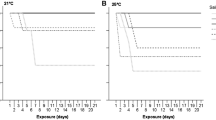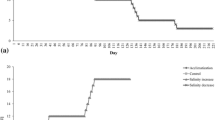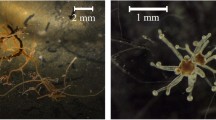Abstract
Salinity is hypothesized to influence the abundance of scyphozoan medusae in the East Asian Marginal Seas, as their spawning largely coincides with the summer monsoon season, and extreme rainfalls subject planulae to reduced salinity, presumably jeopardizing the recruitment of polyps. We examined the effects of different salinities (5, 10, 15, 20, 25, and 32) on body size, swimming speed, survivorship and settlement of planulae, and subsequent development of metamorphosed polyps of three bloom-forming scyphozoans: Chrysaora pacifica, Nemopilema nomurai, and Rhopilema esculentum. Their physiology and behaviors were affected by osmotic stress, but differed by species. At 5, planulae of all species died. At 10, C. pacifica could not settle but survived as plankton, whereas N. nomurai and R. esculentum could settle and develop into four-tentacle polyps, yet the former showing delayed development and tentacle abnormalities. The lowest salinities permitting normal recruitment of polyps were 10, 15, and 20 for R. esculentum, N. nomurai, and C. pacifica, respectively. Inter-annual variations in monsoon rainfall can alter hydrographic conditions in the polyp habitats, affecting medusa population sizes in the following year. The robustness to low salinity of R. esculentum and N. nomurai larvae may enable them to establish yet-to-be-identified polyp populations in brackish-water environments.




Similar content being viewed by others
References
Arai, M. N., 1997. A Functional Biology of Scyphozoa. Chapman & Hall, London.
Bayha, K. M. & W. M. Graham, 2014. Nonindigenous marine jellyfish: invasiveness, invisibility, and impacts. In Pitt, K. P. & C. H. Lucas (eds), Jellyfish Blooms. Springer, Dordrecht: 45–77.
Boero, F., L. Brotz, M. J. Gibbons, A. Piraino & S. Zampardi, 2016. Impacts and effects of ocean warming on jellyfish. In Laffoley, D. & J. M. Baxter (eds), Explaining Ocean Qarming: Causes, Scale, Effects and Consequences. Full report. IUCN, Gland: 213–237.
Brewer, R. H., 1976. Larval settling behavior in Cyanea capillata (Cnidaria: Scyphozoa). Biological Bulletin 150: 183–199.
Brotz, L., 2016. Jellyfish fisheries—a global assessment. In Pauly, D. & D. Zeller (eds), Global Atlas of Marine Fisheries: A Critical Appraisal of Catches and Ecosystem Impacts. Island Press, Washington, DC: 110–124.
Brotz, L., W. W. L. Cheung, K. Kleisner, E. Pakhomov & D. Pauly, 2012. Increasing jellyfish populations: trends in large marine ecosystems. Hydrobiologia 690: 3–20.
Calder, D. R., 1982. Life history of the cannonball jellyfish, Stomolophus meleagris L. Agassiz, 1860 (Scyphozoa, Rhizostomida). Biological Bulletin 162: 149–162.
Cargo, D. G., 1979. Observations on the settling behavior of planular larvae of Chrysaora quinquecirrha. International Journal of Invertebrate Reproduction 1: 279–287.
Cartwright, P., S. L. Halgedahl, J. R. Hendricks, R. D. Jarrard, A. C. Marques, A. G. Collins & B. S. Lieberman, 2007. Exceptionally preserved jellyfishes from the Middle Cambrian. PLoS ONE 2: e1121.
Chen, T.-C., S.-Y. Wang, W.-R. Huang & M.-C. Yen, 2004. Variation of the East Asian summer monsoon rainfall. Journal of Climate 17: 744–762.
Condon, R. H., C. M. Duarte, K. A. Pitt, K. L. Robinson, C. H. Lucas, K. R. Sutherland, H. W. Mianzan, M. Bogeberg, J. E. Purcell, M. B. Decker, S. Uye, L. P. Madin, R. D. Brodeur, S. H. D. Haddock, A. Majej, G. D. Parry, E. Eriksen, J. Quiñones, M. Acha, M. Harvey, J. M. Arthur & W. M. Graham, 2013. Recurrent jellyfish blooms are a consequence of global oscillations. Proceedings of the National Academy of Science of the United States of America 110: 1000–1005.
Conley, K. & S. Uye, 2015. Effects of hyposalinity on survival and settlement of moon jellyfish (Aurelia aurita) planulae. Journal of Experimental Marine Biology and Ecology 462: 14–19.
Dawson, M. N., 2003. Macro-morphological variation among cryptic species of the moon jellyfish, Aurelia (Cnidaria: Scyphozoa). Marine Biology 143: 369–379.
Ding, Y. & J. C. L. Chan, 2005. The East Asian summer monsoon: an overview. Meteorology & Atmospheric Physics 89: 117–142.
Dolmer, P. & I. Suane, 1993. Settlement pattern of the scyphozoan Cyanea capllata (L.). Effects of established scyphistomae and water flow. Ophelia 38: 117–126.
Dong, J., B. Wang, Y. Duan, W.-D. Yoon, A. Wang, X. Liu, Y. Li, M. Sun & Y. Chai, 2017. Initial occurrence, ontogenetic distribution-shifts and advection of Nemopilema nomurai (Scyphozoa: Rhizostomeae) in Liaodong Bay, China, from 2005–2015. Marine Ecology Progress Series. https://doi.org/10.3354/meps12272.
Dong, Z., D. Liu & J. K. Keesing, 2014. Contrasting trends in populations of Rhopilema exculentum and Aurelia aurita in Chinese waters. In Pitt, K. A. & C. H. Lucas (eds), Jellyfish Blooms. Springer, Dordrecht: 207–218.
Duarte, C. M., K. Pitt, C. Lucas, J. E. Purcell, S. Uye, K. Robinson, L. Brotz, M. B. Decker, K. R. Sutherland, A. Malej, L. Madin, H. Mianzan, J. M. Gili, V. Fuentes, D. Atienza, F. Pagés, D. Breitburg, J. Malek, W. M. Graham & R. Condon, 2012. Is global ocean sprawl a cause of jellyfish blooms? Frontier in Ecology and the Environment 11: 91–97.
Feng, S., J. Lin, S. Sun, F. Zhang & C. Li, 2017a. Hyposalinity and incremental micro-zooplankton supply in early-developed Nemopilema nomurai polyp survival, growth, and podocyst reproduction. Marine Ecology Progress Series. https://doi.org/10.3354/meps12204.
Feng, S., S. W. Wang, S. Sun, F. Zhang, G. T. Zhang, M. T. Liu & S. Uye, 2017b. Strobilation of three scyphozoans (Aurelia coerulea, Nemopilema nomurai and Rhopilema esculentum) in the field at Jiaozhou Bay, China. Marine Ecology Progress Series. https://doi.org/10.3354/meps12276.
Gambill, M., S. L. McNaughton, M. Kreus & M. A. Peck, 2018. Temperature-dependent settlement of planula larvae of two scyphozoan jellyfish from the North Sea. Estuarine and Coastal Shelf Science 201: 64–71.
Graham, W. M., S. Gelcich, K. L. Robinson, C. M. Duarte, L. Brotz, J. E. Purcell, L. P. Madin, H. Mianzan, K. R. Sutherland, S. Uye, K. A. Pitt, C. H. Lucas, M. Bøgeberg, R. D. Brodeur & R. H. Condon, 2014. Linking human well-being and jellyfish: ecosystem services, impacts, and societal responses. Frontier in Ecology and the Environment 12: 515–523.
Gröndahl, F., 1989. Evidence of gregarious settlement of planula larvae of the scyphozoan Aurelia aurita: an experimental study. Marine Ecology Progress Series 56: 87–93.
Guo, X. & T. Yanagi, 1998. Three-dimensional structure of tidal current in the East China Sea and the Yellow Sea. Journal of Oceanography 54: 651–668.
Hagadorn, J. W., R. H. Dott & D. Damrow, 2002. Stranded on a Late Cambrian shoreline: medusae from central Wisconsin. Geology 30: 147–150.
Halpern, B. S., S. Walbridge, K. A. Selkoe, C. V. Kappel, F. Micheli, C. D’Agrosa, J. F. Bruno, K. S. Casey, C. Ebert, H. E. Fox, R. Fujita, D. Heinemann, H. S. Lenihan, E. M. P. Madin, M. T. Perry, E. R. Selig, M. Spalding, R. Steneck & R. Watson, 2008. A global map of human impact on marine ecosystems. Science 319: 948–952.
Holst, S. & G. Jarms, 2007. Substrate choice and settlement preferences of planula larvae of five Scyphozoa (Cnidaria) from German Bight, North Sea. Marine Biology 151: 863–871.
Holst, S. & G. Jarms, 2010. Effect of low salinity on settlement and strobilation of scyphozoan (Cnidaria): is the lion’s mane Cyanea capillata (L.) able to reproduce in the brackish Baltic Bea? Hydrobiologia 645: 53–68.
Hsieh, Y.-H. P., F.-M. Leong & J. Rudloe, 2001. Jellyfish as food. Hydrobiologia 451: 11–17.
Ikeda, H., K. Ohtsu & S. Uye, 2011. Structural changes of gonads during artificially induced gamatogenesis and spawning in the giant jellyfish Nemopilema nomurai (Schphozoa: Rhizostomeae). Journal of Marine Biological Association of the United Kingdom 91: 215–227.
Kawahara, M., S. Uye, K. Ohtsu & H. Iizumi, 2006. Unusual population explosion of the giant jellyfish Nemopilema nomurai (Scyphozoa: Rhizostomeae) in East Asian waters. Marine Ecology Progress Series 307: 161–173.
Keen, S. L., 1987. Recruitment of Aurelia aurita (Cnidaria: Scyhozoa) larvae is position-dependent, and independent of conspecific density, within a settling surface. Marine Ecology Progress Series 38: 151–160.
Kim, D. H., J. N. Seo, Y. N. Yoon & Y.-S. Suh, 2012. Estimating the economic damage caused by jellyfish to fisheries in Korea. Fisheries Science 78: 1147–1152.
Kinoshita, J., J. Hiromi & Y. Yamada, 2006. Abundance and biomass of scyphomedusae, Aurelia aurita and Chysaora melanaster, and ctenophore, Bolinopsis mikado, with estimates of their feeding impact on zooplankton in Tokyo Bay, Japan. Journal of Oceanography 62: 607–615.
Lucas, C. H., W. M. Graham & C. Widmer, 2012. Jellyfish life histories: role of polyps in forming and maintaining scyphomedusa populations. Advance in Marine Biology 63: 133–196.
Magni, P. & S. Montani, 2000. Water chemistry variability in the lower intertidal zone of an estuary in the Seto Inland Sea, Japan: seasonal patterns of nutrients and particulate compounds. Hydrobiologia 432: 9–23.
Makabe, R., R. Furukawa, M. Takao & S. Uye, 2014. Marine artificial structures as amplifiers of Aurelia aurita s.l. blooms: a case study of a newly installed floating pier. Journal of Oceanography 70: 447–455.
Makabe, R., H. Takeoka & S. Uye, 2015. Offshore dispersion of ephyrae and medusae of Aurelia aurita s.l. (Cnidaria: Scyphozoa) from port enclosures: Physical and biological factors. Journal of Marine Systems 152: 75–82.
Malej, A., T. Kogovšek & S. Uye, 2014. Medusae—Pest or resource for humans? Biologia Marina Mediterranea 21: 2–9.
Manda, A., H. Nakamura, N. Asano, S. Iizuka, T. Miyama, Q. Moteki, M. K. Yoshioka, K. Nishii & T. Miyasaka, 2014. Impacts of a warming marginal sea on torrential rainfall organized under the Asian summer monsoon. Scientific Reports 4: 1–6.
Matsuda, O., Y. Kishimoto & S. Hamasaki, 1990. Factors affecting seasonal variation of oceanographic conditions at Kure Port. Journal of Faculty of Applied Biological Science, Hiroshima University 29: 135–144. (in Japanese with English abstract).
Miyake, H., K. Iwao & Y. Kakinuma, 1997. Life history and environment of Aurelia aurita. South Pacific Study 17: 273–285.
Miyake, H., M. Terazaki & Y. Kakinuma, 2002. On the polyps of the common jellyfish Aurelia aurita in Kagoshima Bay. Journal of Oceanography 58: 451–459.
Ohtsu, K., M. Kawahara, H. Ikeda & S. Uye, 2007. Experimental induction of gonadal maturation and spawning in the giant jellyfish Nemopilema nomurai (Schyphozoa: Rhizostomeae). Marine Biology 152: 667–676.
Peneda, J., 2000. Linking larval settlement to larval transport: assumptions, potentials, and pitfalls. Oceanography of the Eastern Pacific 1: 84–105.
Pitt, K. P. & C. H. Lucas (eds), 2014. Jellyfish Blooms. Springer, Dordrecht.
Prieto, L., D. Astorga, G. Navarro & J. Ruiz, 2010. Environmental control of phase transition and polyp survival of massive-outbreaker jellyfish. PLoS ONE 5: e13793.
Purcell, J. E., 2012. Jellyfish and ctenophore blooms coincide with human proliferations and environmental perturbations. Annual Review in Marine Science 4: 209–235.
Purcell, J. E., S. Uye & L. T. Lo, 2007. Anthropogenic causes of jellyfish blooms and their direct consequences for humans: a review. Marine Ecology Progress Series 350: 153–174.
Purcell, J. E., R. A. Hoover & N. T. Schwarck, 2009. Interannual variation of strobilation by the scyphozoan Aurelia labiata in relation to polyp density, temperature, salinity, and light conditions in situ. Marine Ecology Progress Series 375: 139–149.
Riascos, J. M., L. Paredes, K. González, I. Cáceres & A. Pacheco, 2013. The larval and benthic stages of the scyphozoan medusa Chrysaora plocamia under El Niño-La Niña thermal regimes. Journal of Experimental Marine Biology and Ecology 446: 95–101.
Richardson, A. J., A. Bakun, G. C. Hays & M. J. Gibbons, 2009. The jellyfish joyride: causes, consequences and management responses to a more gelatinous future. Trends in Ecology and Evolution 24: 312–322.
Russel, F. S., 1970. The Medusae of the British Isle. II. Pelagic Scyphozoa with a Supplement to the First Volume on Hydromedusae. Cambridge University Press, Cambridge.
Schneider, G. & T. Weisse, 1985. Metabolism measurements of Aurelia aurita planulae larvae, and calculation of maximal survival period of the free swimming stage. Helgoland Marine Research 39: 43–47.
Scorrano, S., G. Aglieri, F. Boero, M. N. Dawson & S. Piraino, 2016. Unmasking Aurelia species in the Mediterranean Sea: an integrative morphometric and molecular approach. Zoological Journal of Linnean Society. https://doi.org/10.1111/zoj.12494.
Song, S., F. Zhang, C. Li, S. Wang, M. Wang, Z. Tao, Y. Wang, G. Zhang & X. Sun, 2015. Breeding places, population dynamics, and distribution of the giant jellyfish Nemopilema nomurai (Scyphozoa: Rhizostomeae) in the Yellow Sea and the East China Sea. Hydrobiologia 754: 59–74.
Sun, Y. & Y. Ding, 2010. A projection of future changes in summer precipitation and monsoon in East Asia. Science China Earth Science 53: 284–300.
Thein, H., H. Ikeda & S. Uye, 2013. Ecophysiological characteristics of podocysts in Chrysaora pacifica (Goette) and Cyanea nozakii Kishinouye (Cnidaria: Scyphozoa: Semaeostomeae): Effects of environmental factors on their production, dormancy and excystment. Journao of Experimental Marine Biology and Ecology 446: 151–158.
Toyokawa, M., 2011. First record of wild polyps of Chrysaora pacifica (Goette, 1886) (Scyphozoa, Cnidaria). Plankton Benthos Research 6: 175–177.
Toyokawa, M., M. Shibata, J. H. Cheng, H. Y. Li, J. Z. Ling, N. Lin, Z. L. Liu, Y. Zhang, M. Shimizu & H. Akiyama, 2012. First record of wild ephyrae of the giant jellyfish Nemopilema nomurai. Fisheries Science 78: 1213–1218.
Uye, S., 2011. Human forcing of the copepod-fish-jellyfish triangular trophic relationship. Hydrobiologia 666: 71–83.
Uye, S., 2014. The giant jellyfish Nemopilema nomurai in East Asian Marginal Seas. In Pitt, K. A. & C. H. Lucas (eds), Jellyfish Blooms. Springer, Dordrecht: 185–205.
Uye, S. & U. Ueta, 2004. Recent increase of jellyfish populations and their nuisance to fisheries in the Inland Sea of Japan. Japanese Society of Fisheries Oceanography 68: 9–19. (in Japanese with English abstract).
Wang, B., Y. B. Qi, J. Dong, Y. L. Li, W. B. Wang, Y. P. Li, M. Sun & Y. Liu, 2013. Dynamic distribution of Nemopilema nomurai in inshore waters of the northern Liaodong Bay, Bohai Sea. Acta Ecologica Sinica 33: 1701–1712.
Wang, Y. & L. Zhou, 2005. Observed trends in extreme precipitation events in China during 1961–2001 and the associated changes in large-scale circulation. Geophysical Reearchg Letters. https://doi.org/10.1029/2005GL022574.
Webster, C. N. & C. H. Lucas, 2012. The effect of food and temperature on settlement of Aurelia aurita planula larvae ans subsequent somatic growth. Journal of Experimental Marine Biology and Ecology 436: 50–55.
Weiler, K. S. & R. E. Black, 1991. Immediate decrease in apparent translation rate caused by salinity change in scyphistomae of Aurelia aurita (Linnaeus). Comparative Biochemistry and Physiology A 99: 199–202.
Willcox, S., N. A. Moltschaniwskyj & C. M. Crawford, 2008. Population dynamics of natural colonies of Aurelia sp. scyphistomae in Tasmania. Australia. Marine Biology 154: 661–670.
Yoon, W. D., S. H. Choi, C. Han & W. G. Park, 2014. Rock preference of planulae of jellyfish Aurelia aurita (Linnaeus 1758) for settlement in the laboratory. Ocean Science 49: 163–166.
Acknowledgements
We would like to thank Keats Conley for her valuable comments on an early version of the manuscript and Hideki Ikeda for his assistance in field sampling. We are also grateful to two anonymous reviewers for helpful comments. This work was partially supported by a Grant from the Agriculture, Forestry and Fisheries Research Council, Japan (Project name: STOPJELLY), and JSPS KAKENHI (No. 16K07826).
Author information
Authors and Affiliations
Corresponding author
Additional information
Handling editor: Juan Carlos Molinero
Rights and permissions
About this article
Cite this article
Takao, M., Uye, Si. Effects of low salinity on the physiological ecology of planulae and polyps of scyphozoans in the East Asian Marginal Seas: potential impacts of monsoon rainfall on medusa population size. Hydrobiologia 815, 165–176 (2018). https://doi.org/10.1007/s10750-018-3558-3
Received:
Revised:
Accepted:
Published:
Issue Date:
DOI: https://doi.org/10.1007/s10750-018-3558-3




